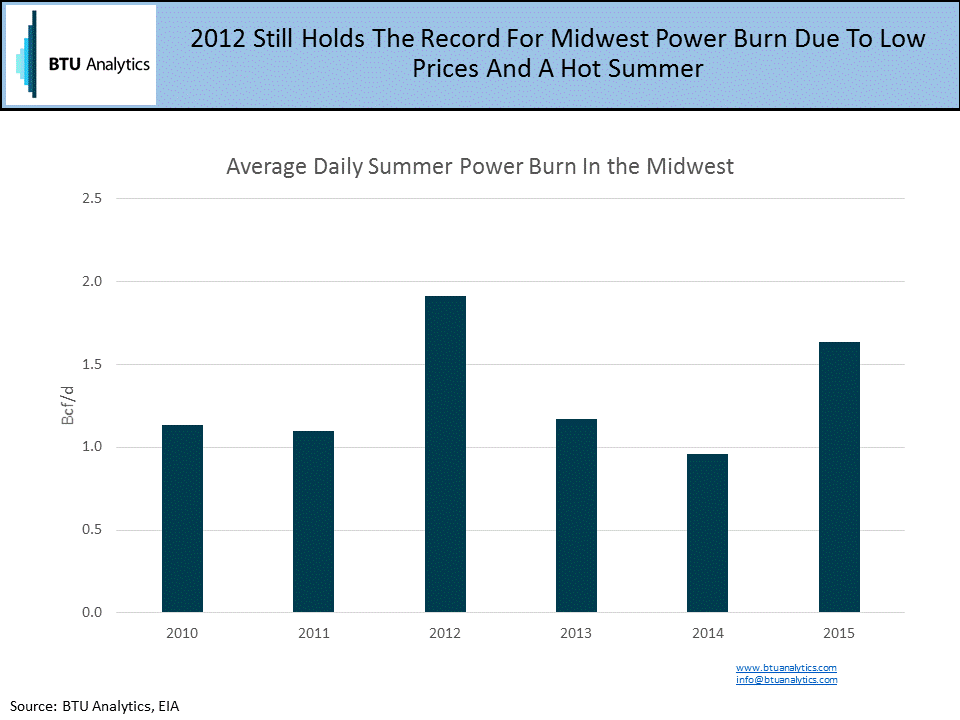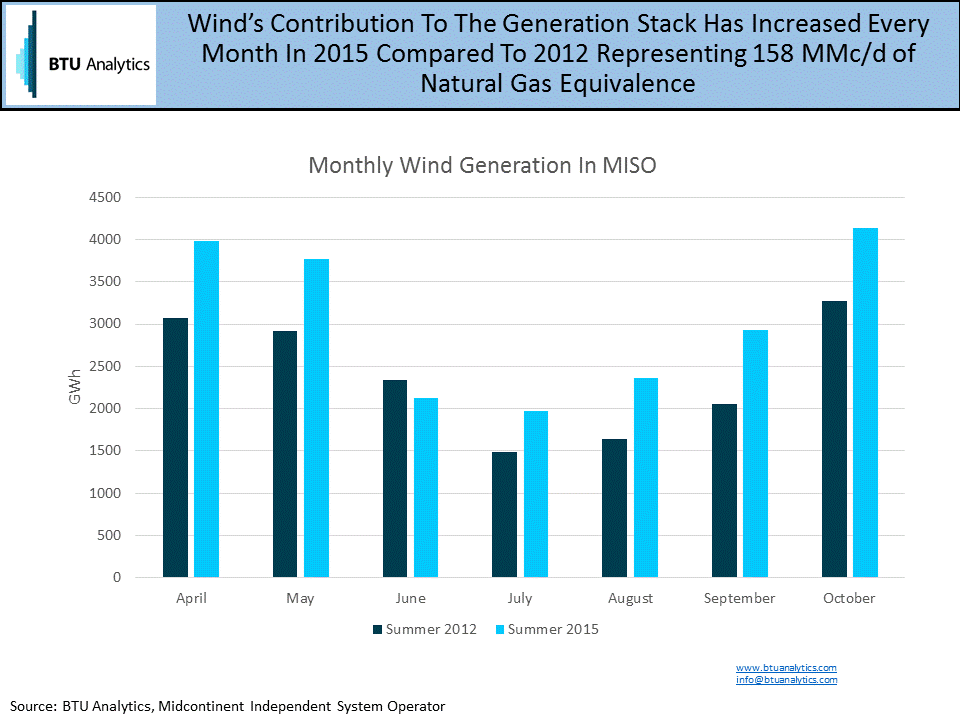The US gas market is out of balance and the warm winter the US is experiencing isn’t helping. To soak up excess supply next summer, the US will need to see extensive amounts of coal-to-gas switching or producer shut-ins to balance. BTU Analytics’ has received a lot of questions recently about where switching will occur next summer and at what levels we may see. In this post, we dive into the Midwest to quantify what has changed since 2012, the last time natural gas markets were below $2/MMbtu, and highlight how those changes might change burn.
In the summer of 2012, the Midwest (MO, IL, IN, IA, MN, MI, and WI) noted a large jump in the consumption of natural gas by the power sector (power burn) compared to the previous two summers. Regional consumption grew from an average of 1.1 Bcf/d in the summers of 2010 and 2011 to average 1.9 Bcf/d the summer of 2012. This jump in consumption was aided by the hottest July on record in the Midwest and High Plains regions of the MISO system and the low price environment.

For coal-to-gas switching to occur, the price of natural gas needs to drop below the delivered cost of coal as we outlined in our previous post Coal To Gas Switching in 2016. EIA 923 data shows the average weighted price of coal delivered in the Midwest was $2.29 in 2012. Chicago Citygate pricing was under that level for 41 days that summer and averaged $2.77 for the season. Through the first three quarters of 2015, the average weighted price of coal delivered to the Midwest dropped to $2.18, with 65% of volumes coming from the Powder River Basin in Wyoming. Chicago Citygate natural gas pricing was only under that level 2 times this summer and has averaged $2.69, yet natural gas burn has climbed to over 1.5 Bcf/d. So whats driving the changes in the region if not price?
Since 2012, about 3.8 GW of coal plant retirements have occurred which equates to about 355 MMcf/d of natural gas demand. Offsetting some of this lost generation was the startup of the Prairie State Generating Station, a 1.6 GW coal plant in Illinois that entered service in late 2012 and has since then run at an average utilization rate of 59% which equates to roughly 171 MMcf/d of natural gas demand.
Over that same time, 4.5 GW of wind capacity has been installed on top of the 12 GW that was already operating in the region. According to MISO, whose footprint is slightly smaller than the BTU Analytics’ Midwest region, wind provided 99,509 MWh of energy per day this summer compared to 78,434 MWh in 2012. This additional supply of power equates to 158 MMcf/d of natural gas demand.

As you can see, a lot has changed in the Midwest since 2012. Coal plant retirements were offset with one new coal plant and additional wind generation, leaving natural gas roughly 26 MMcf/d of new demand potential from coal retirements. Despite the average price of gas sitting above the average delivered price of coal for most of the summer, and despite changes in the generation stack that are not fully favorable to natural gas, burn came in only 0.2 Bcf/d below 2012 levels this past summer and nearly 0.6 Bcf/d above 2014. But what’s the reason?
One part of the story could be coal stockpiles. The chart below shows coal stockpiles by rank at electric power facilities in the US. The winters of 2013/2014 and 2014/2015 brought record cold and thus high electric load for space heating which substantially reduced coal stockpiles at key generating facilities. Since then stockpiles have grown steadily as power producers rushed to replenish stocks to desirable levels. Some generators have even had to curtail coal generation due to low stockpiles over this period. As a result of this concern, gas may have had the ability to gain market share despite prices being above the ‘sweet zone’ for switching.

As we move to 2016, switching in the Midwest will be a battle between coal and gas producers. Baring a hot summer in 2016, BTU Analytics expects Midwest to grow again compared to this summer and average 1.8 Bcf/d. Add in high load due to a hot summer and demand could spike to well over 2 Bcf/d. But for this all to happen, prices will need to stay low, a $1 handle low. For more information on BTU Analytics’ demand outlook, request a sample of BTU Analytics Northeast Gas Quarterly and register to attend our upcoming conference, What Lies Ahead, taking place February 4th in Houston, TX.








